Analysis of Laws Implemented in the Nursing Workplace: Case Studies
VerifiedAdded on 2020/02/24
|9
|2481
|85
Report
AI Summary
This report analyzes three case studies involving nursing students and registered nurses, focusing on the application of workplace laws and ethical guidelines. The first case examines the misuse of narcotic analgesia by nursing students, highlighting violations of the Nursing and Midwifery Board of Australia (NMBA) code of ethics and potential breaches of the Queensland Work Health and Safety Act. The second case explores the arrest of a newly registered nurse for possessing MDMA, discussing the implications of the NMBA's code of professional conduct and the grounds for voluntary notification. The final case involves a student drinking alcohol and posting pictures in uniform, addressing the NMBA's code of conduct and mandatory notification requirements. The report emphasizes the importance of adhering to ethical standards, ensuring patient safety, and understanding the consequences of violating workplace regulations. It provides a comprehensive overview of the legal and ethical considerations in nursing practice, supported by relevant references.
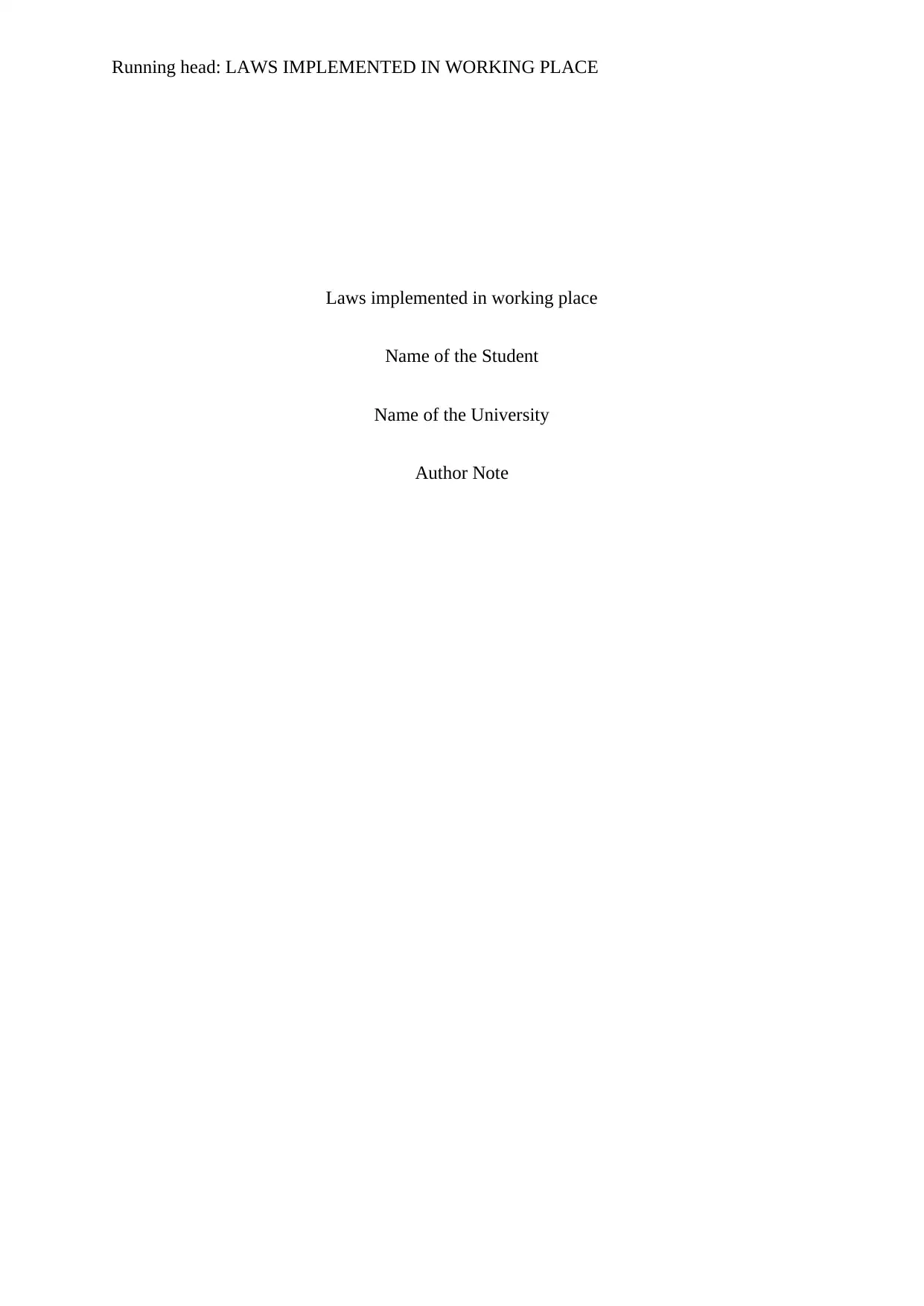
Running head: LAWS IMPLEMENTED IN WORKING PLACE
Laws implemented in working place
Name of the Student
Name of the University
Author Note
Laws implemented in working place
Name of the Student
Name of the University
Author Note
Paraphrase This Document
Need a fresh take? Get an instant paraphrase of this document with our AI Paraphraser
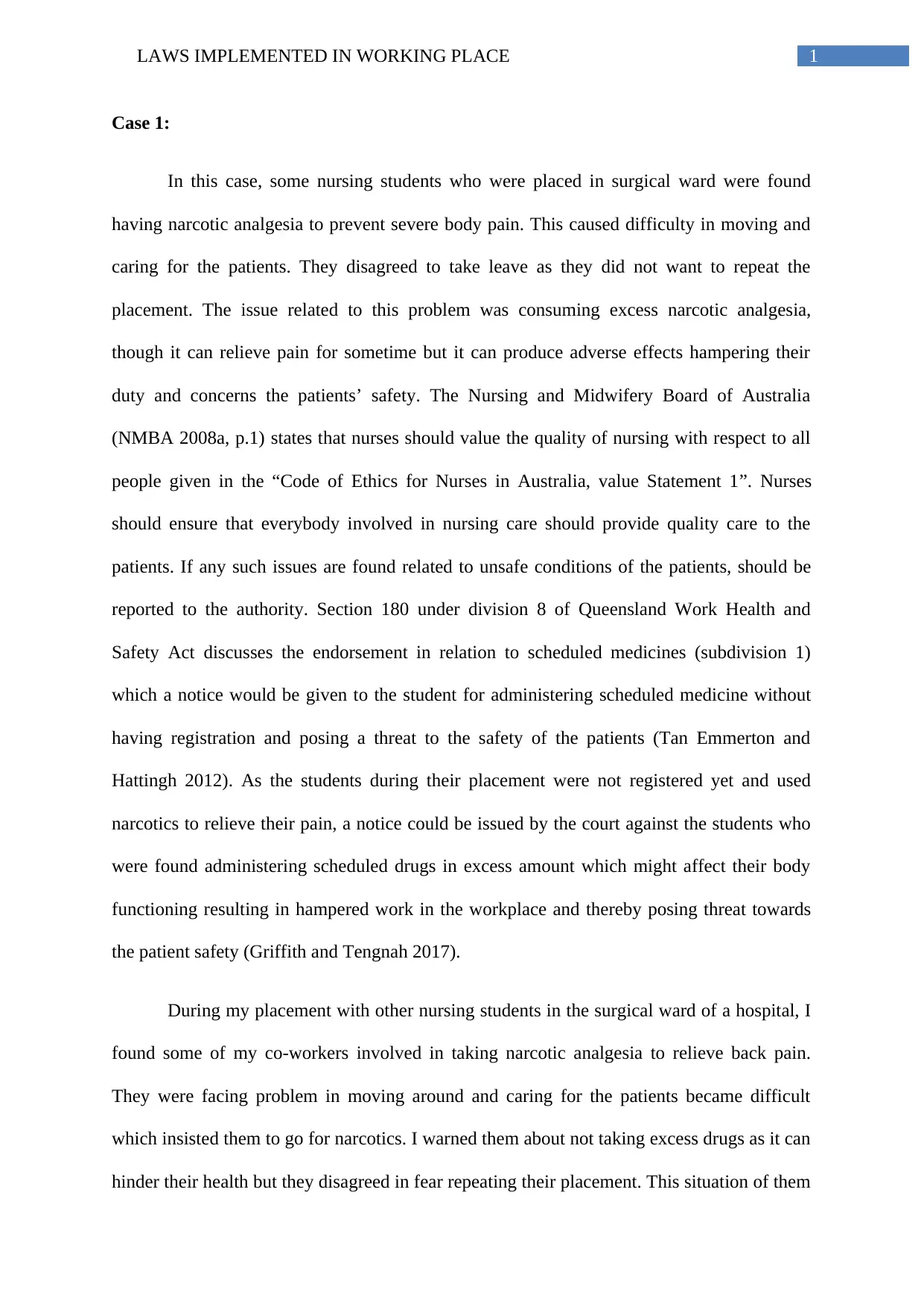
1LAWS IMPLEMENTED IN WORKING PLACE
Case 1:
In this case, some nursing students who were placed in surgical ward were found
having narcotic analgesia to prevent severe body pain. This caused difficulty in moving and
caring for the patients. They disagreed to take leave as they did not want to repeat the
placement. The issue related to this problem was consuming excess narcotic analgesia,
though it can relieve pain for sometime but it can produce adverse effects hampering their
duty and concerns the patients’ safety. The Nursing and Midwifery Board of Australia
(NMBA 2008a, p.1) states that nurses should value the quality of nursing with respect to all
people given in the “Code of Ethics for Nurses in Australia, value Statement 1”. Nurses
should ensure that everybody involved in nursing care should provide quality care to the
patients. If any such issues are found related to unsafe conditions of the patients, should be
reported to the authority. Section 180 under division 8 of Queensland Work Health and
Safety Act discusses the endorsement in relation to scheduled medicines (subdivision 1)
which a notice would be given to the student for administering scheduled medicine without
having registration and posing a threat to the safety of the patients (Tan Emmerton and
Hattingh 2012). As the students during their placement were not registered yet and used
narcotics to relieve their pain, a notice could be issued by the court against the students who
were found administering scheduled drugs in excess amount which might affect their body
functioning resulting in hampered work in the workplace and thereby posing threat towards
the patient safety (Griffith and Tengnah 2017).
During my placement with other nursing students in the surgical ward of a hospital, I
found some of my co-workers involved in taking narcotic analgesia to relieve back pain.
They were facing problem in moving around and caring for the patients became difficult
which insisted them to go for narcotics. I warned them about not taking excess drugs as it can
hinder their health but they disagreed in fear repeating their placement. This situation of them
Case 1:
In this case, some nursing students who were placed in surgical ward were found
having narcotic analgesia to prevent severe body pain. This caused difficulty in moving and
caring for the patients. They disagreed to take leave as they did not want to repeat the
placement. The issue related to this problem was consuming excess narcotic analgesia,
though it can relieve pain for sometime but it can produce adverse effects hampering their
duty and concerns the patients’ safety. The Nursing and Midwifery Board of Australia
(NMBA 2008a, p.1) states that nurses should value the quality of nursing with respect to all
people given in the “Code of Ethics for Nurses in Australia, value Statement 1”. Nurses
should ensure that everybody involved in nursing care should provide quality care to the
patients. If any such issues are found related to unsafe conditions of the patients, should be
reported to the authority. Section 180 under division 8 of Queensland Work Health and
Safety Act discusses the endorsement in relation to scheduled medicines (subdivision 1)
which a notice would be given to the student for administering scheduled medicine without
having registration and posing a threat to the safety of the patients (Tan Emmerton and
Hattingh 2012). As the students during their placement were not registered yet and used
narcotics to relieve their pain, a notice could be issued by the court against the students who
were found administering scheduled drugs in excess amount which might affect their body
functioning resulting in hampered work in the workplace and thereby posing threat towards
the patient safety (Griffith and Tengnah 2017).
During my placement with other nursing students in the surgical ward of a hospital, I
found some of my co-workers involved in taking narcotic analgesia to relieve back pain.
They were facing problem in moving around and caring for the patients became difficult
which insisted them to go for narcotics. I warned them about not taking excess drugs as it can
hinder their health but they disagreed in fear repeating their placement. This situation of them
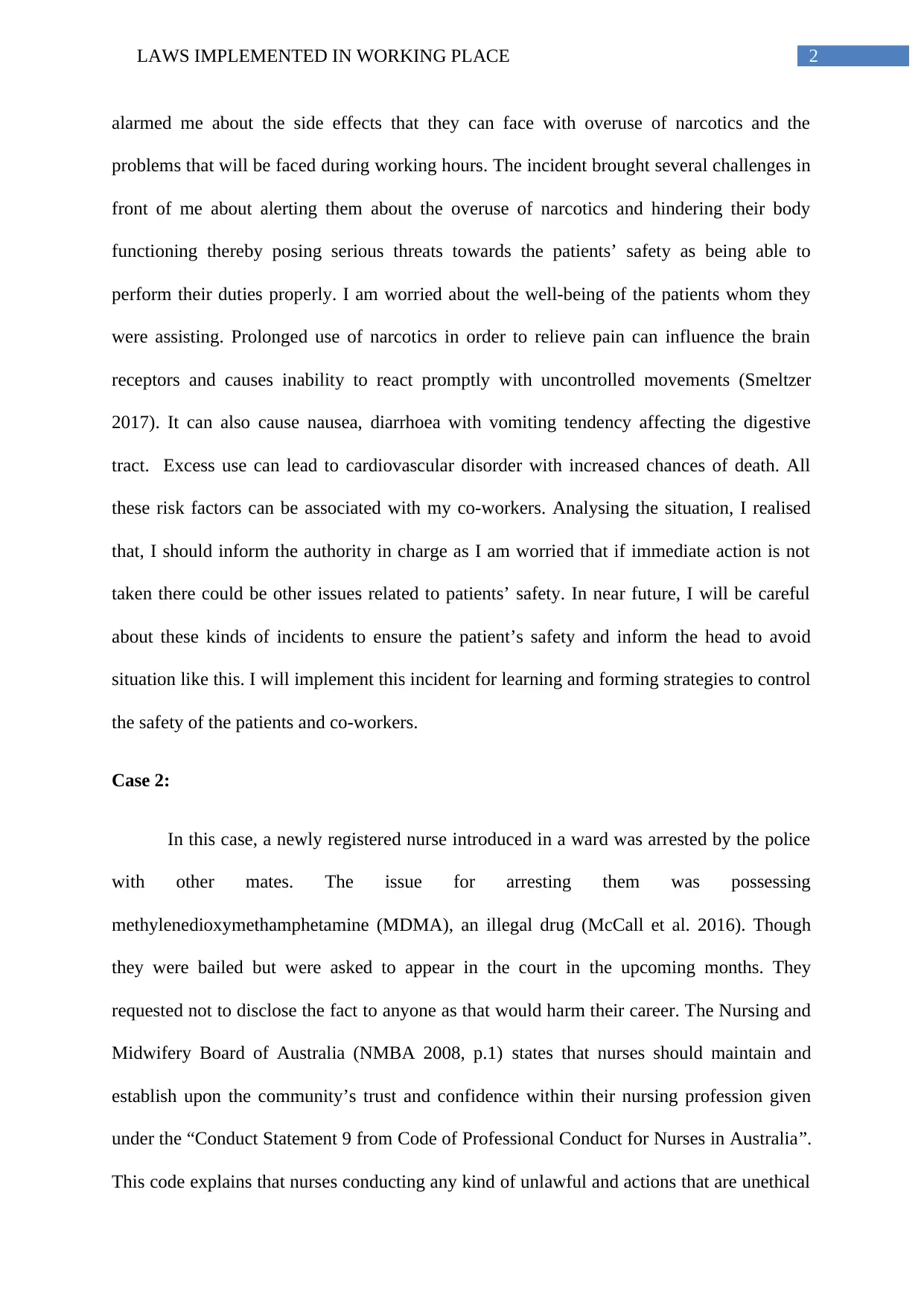
2LAWS IMPLEMENTED IN WORKING PLACE
alarmed me about the side effects that they can face with overuse of narcotics and the
problems that will be faced during working hours. The incident brought several challenges in
front of me about alerting them about the overuse of narcotics and hindering their body
functioning thereby posing serious threats towards the patients’ safety as being able to
perform their duties properly. I am worried about the well-being of the patients whom they
were assisting. Prolonged use of narcotics in order to relieve pain can influence the brain
receptors and causes inability to react promptly with uncontrolled movements (Smeltzer
2017). It can also cause nausea, diarrhoea with vomiting tendency affecting the digestive
tract. Excess use can lead to cardiovascular disorder with increased chances of death. All
these risk factors can be associated with my co-workers. Analysing the situation, I realised
that, I should inform the authority in charge as I am worried that if immediate action is not
taken there could be other issues related to patients’ safety. In near future, I will be careful
about these kinds of incidents to ensure the patient’s safety and inform the head to avoid
situation like this. I will implement this incident for learning and forming strategies to control
the safety of the patients and co-workers.
Case 2:
In this case, a newly registered nurse introduced in a ward was arrested by the police
with other mates. The issue for arresting them was possessing
methylenedioxymethamphetamine (MDMA), an illegal drug (McCall et al. 2016). Though
they were bailed but were asked to appear in the court in the upcoming months. They
requested not to disclose the fact to anyone as that would harm their career. The Nursing and
Midwifery Board of Australia (NMBA 2008, p.1) states that nurses should maintain and
establish upon the community’s trust and confidence within their nursing profession given
under the “Conduct Statement 9 from Code of Professional Conduct for Nurses in Australia”.
This code explains that nurses conducting any kind of unlawful and actions that are unethical
alarmed me about the side effects that they can face with overuse of narcotics and the
problems that will be faced during working hours. The incident brought several challenges in
front of me about alerting them about the overuse of narcotics and hindering their body
functioning thereby posing serious threats towards the patients’ safety as being able to
perform their duties properly. I am worried about the well-being of the patients whom they
were assisting. Prolonged use of narcotics in order to relieve pain can influence the brain
receptors and causes inability to react promptly with uncontrolled movements (Smeltzer
2017). It can also cause nausea, diarrhoea with vomiting tendency affecting the digestive
tract. Excess use can lead to cardiovascular disorder with increased chances of death. All
these risk factors can be associated with my co-workers. Analysing the situation, I realised
that, I should inform the authority in charge as I am worried that if immediate action is not
taken there could be other issues related to patients’ safety. In near future, I will be careful
about these kinds of incidents to ensure the patient’s safety and inform the head to avoid
situation like this. I will implement this incident for learning and forming strategies to control
the safety of the patients and co-workers.
Case 2:
In this case, a newly registered nurse introduced in a ward was arrested by the police
with other mates. The issue for arresting them was possessing
methylenedioxymethamphetamine (MDMA), an illegal drug (McCall et al. 2016). Though
they were bailed but were asked to appear in the court in the upcoming months. They
requested not to disclose the fact to anyone as that would harm their career. The Nursing and
Midwifery Board of Australia (NMBA 2008, p.1) states that nurses should maintain and
establish upon the community’s trust and confidence within their nursing profession given
under the “Conduct Statement 9 from Code of Professional Conduct for Nurses in Australia”.
This code explains that nurses conducting any kind of unlawful and actions that are unethical
⊘ This is a preview!⊘
Do you want full access?
Subscribe today to unlock all pages.

Trusted by 1+ million students worldwide
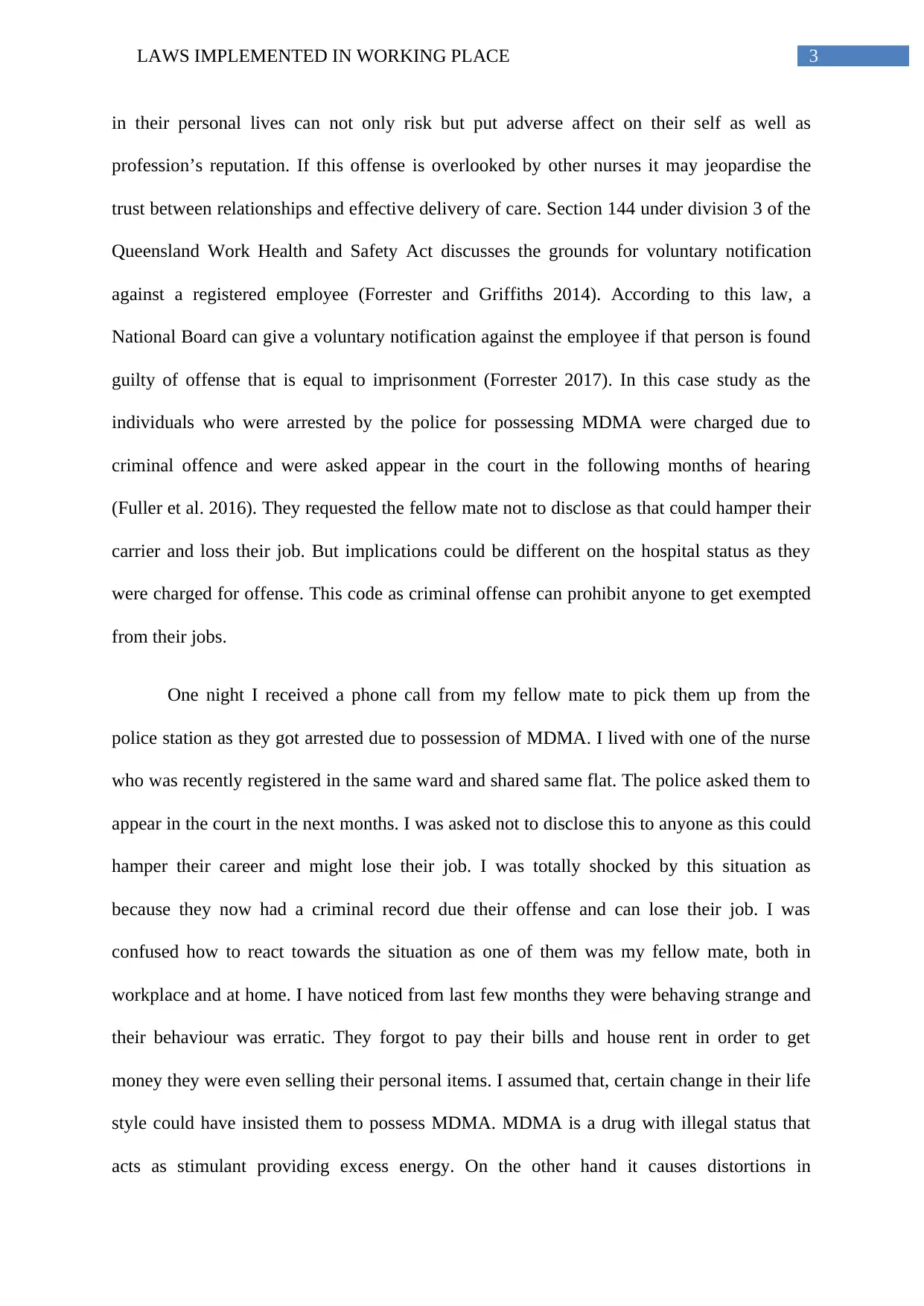
3LAWS IMPLEMENTED IN WORKING PLACE
in their personal lives can not only risk but put adverse affect on their self as well as
profession’s reputation. If this offense is overlooked by other nurses it may jeopardise the
trust between relationships and effective delivery of care. Section 144 under division 3 of the
Queensland Work Health and Safety Act discusses the grounds for voluntary notification
against a registered employee (Forrester and Griffiths 2014). According to this law, a
National Board can give a voluntary notification against the employee if that person is found
guilty of offense that is equal to imprisonment (Forrester 2017). In this case study as the
individuals who were arrested by the police for possessing MDMA were charged due to
criminal offence and were asked appear in the court in the following months of hearing
(Fuller et al. 2016). They requested the fellow mate not to disclose as that could hamper their
carrier and loss their job. But implications could be different on the hospital status as they
were charged for offense. This code as criminal offense can prohibit anyone to get exempted
from their jobs.
One night I received a phone call from my fellow mate to pick them up from the
police station as they got arrested due to possession of MDMA. I lived with one of the nurse
who was recently registered in the same ward and shared same flat. The police asked them to
appear in the court in the next months. I was asked not to disclose this to anyone as this could
hamper their career and might lose their job. I was totally shocked by this situation as
because they now had a criminal record due their offense and can lose their job. I was
confused how to react towards the situation as one of them was my fellow mate, both in
workplace and at home. I have noticed from last few months they were behaving strange and
their behaviour was erratic. They forgot to pay their bills and house rent in order to get
money they were even selling their personal items. I assumed that, certain change in their life
style could have insisted them to possess MDMA. MDMA is a drug with illegal status that
acts as stimulant providing excess energy. On the other hand it causes distortions in
in their personal lives can not only risk but put adverse affect on their self as well as
profession’s reputation. If this offense is overlooked by other nurses it may jeopardise the
trust between relationships and effective delivery of care. Section 144 under division 3 of the
Queensland Work Health and Safety Act discusses the grounds for voluntary notification
against a registered employee (Forrester and Griffiths 2014). According to this law, a
National Board can give a voluntary notification against the employee if that person is found
guilty of offense that is equal to imprisonment (Forrester 2017). In this case study as the
individuals who were arrested by the police for possessing MDMA were charged due to
criminal offence and were asked appear in the court in the following months of hearing
(Fuller et al. 2016). They requested the fellow mate not to disclose as that could hamper their
carrier and loss their job. But implications could be different on the hospital status as they
were charged for offense. This code as criminal offense can prohibit anyone to get exempted
from their jobs.
One night I received a phone call from my fellow mate to pick them up from the
police station as they got arrested due to possession of MDMA. I lived with one of the nurse
who was recently registered in the same ward and shared same flat. The police asked them to
appear in the court in the next months. I was asked not to disclose this to anyone as this could
hamper their career and might lose their job. I was totally shocked by this situation as
because they now had a criminal record due their offense and can lose their job. I was
confused how to react towards the situation as one of them was my fellow mate, both in
workplace and at home. I have noticed from last few months they were behaving strange and
their behaviour was erratic. They forgot to pay their bills and house rent in order to get
money they were even selling their personal items. I assumed that, certain change in their life
style could have insisted them to possess MDMA. MDMA is a drug with illegal status that
acts as stimulant providing excess energy. On the other hand it causes distortions in
Paraphrase This Document
Need a fresh take? Get an instant paraphrase of this document with our AI Paraphraser
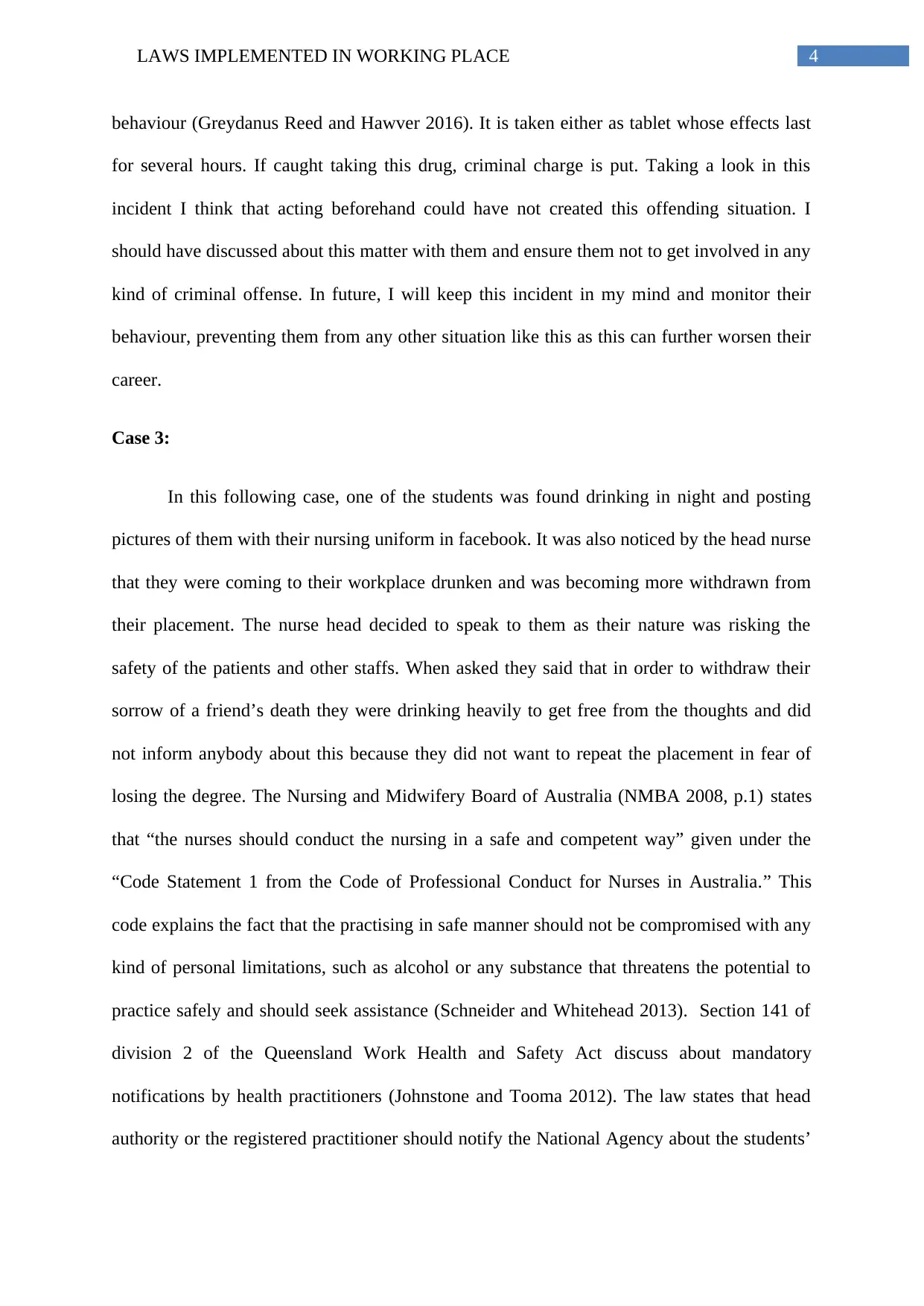
4LAWS IMPLEMENTED IN WORKING PLACE
behaviour (Greydanus Reed and Hawver 2016). It is taken either as tablet whose effects last
for several hours. If caught taking this drug, criminal charge is put. Taking a look in this
incident I think that acting beforehand could have not created this offending situation. I
should have discussed about this matter with them and ensure them not to get involved in any
kind of criminal offense. In future, I will keep this incident in my mind and monitor their
behaviour, preventing them from any other situation like this as this can further worsen their
career.
Case 3:
In this following case, one of the students was found drinking in night and posting
pictures of them with their nursing uniform in facebook. It was also noticed by the head nurse
that they were coming to their workplace drunken and was becoming more withdrawn from
their placement. The nurse head decided to speak to them as their nature was risking the
safety of the patients and other staffs. When asked they said that in order to withdraw their
sorrow of a friend’s death they were drinking heavily to get free from the thoughts and did
not inform anybody about this because they did not want to repeat the placement in fear of
losing the degree. The Nursing and Midwifery Board of Australia (NMBA 2008, p.1) states
that “the nurses should conduct the nursing in a safe and competent way” given under the
“Code Statement 1 from the Code of Professional Conduct for Nurses in Australia.” This
code explains the fact that the practising in safe manner should not be compromised with any
kind of personal limitations, such as alcohol or any substance that threatens the potential to
practice safely and should seek assistance (Schneider and Whitehead 2013). Section 141 of
division 2 of the Queensland Work Health and Safety Act discuss about mandatory
notifications by health practitioners (Johnstone and Tooma 2012). The law states that head
authority or the registered practitioner should notify the National Agency about the students’
behaviour (Greydanus Reed and Hawver 2016). It is taken either as tablet whose effects last
for several hours. If caught taking this drug, criminal charge is put. Taking a look in this
incident I think that acting beforehand could have not created this offending situation. I
should have discussed about this matter with them and ensure them not to get involved in any
kind of criminal offense. In future, I will keep this incident in my mind and monitor their
behaviour, preventing them from any other situation like this as this can further worsen their
career.
Case 3:
In this following case, one of the students was found drinking in night and posting
pictures of them with their nursing uniform in facebook. It was also noticed by the head nurse
that they were coming to their workplace drunken and was becoming more withdrawn from
their placement. The nurse head decided to speak to them as their nature was risking the
safety of the patients and other staffs. When asked they said that in order to withdraw their
sorrow of a friend’s death they were drinking heavily to get free from the thoughts and did
not inform anybody about this because they did not want to repeat the placement in fear of
losing the degree. The Nursing and Midwifery Board of Australia (NMBA 2008, p.1) states
that “the nurses should conduct the nursing in a safe and competent way” given under the
“Code Statement 1 from the Code of Professional Conduct for Nurses in Australia.” This
code explains the fact that the practising in safe manner should not be compromised with any
kind of personal limitations, such as alcohol or any substance that threatens the potential to
practice safely and should seek assistance (Schneider and Whitehead 2013). Section 141 of
division 2 of the Queensland Work Health and Safety Act discuss about mandatory
notifications by health practitioners (Johnstone and Tooma 2012). The law states that head
authority or the registered practitioner should notify the National Agency about the students’
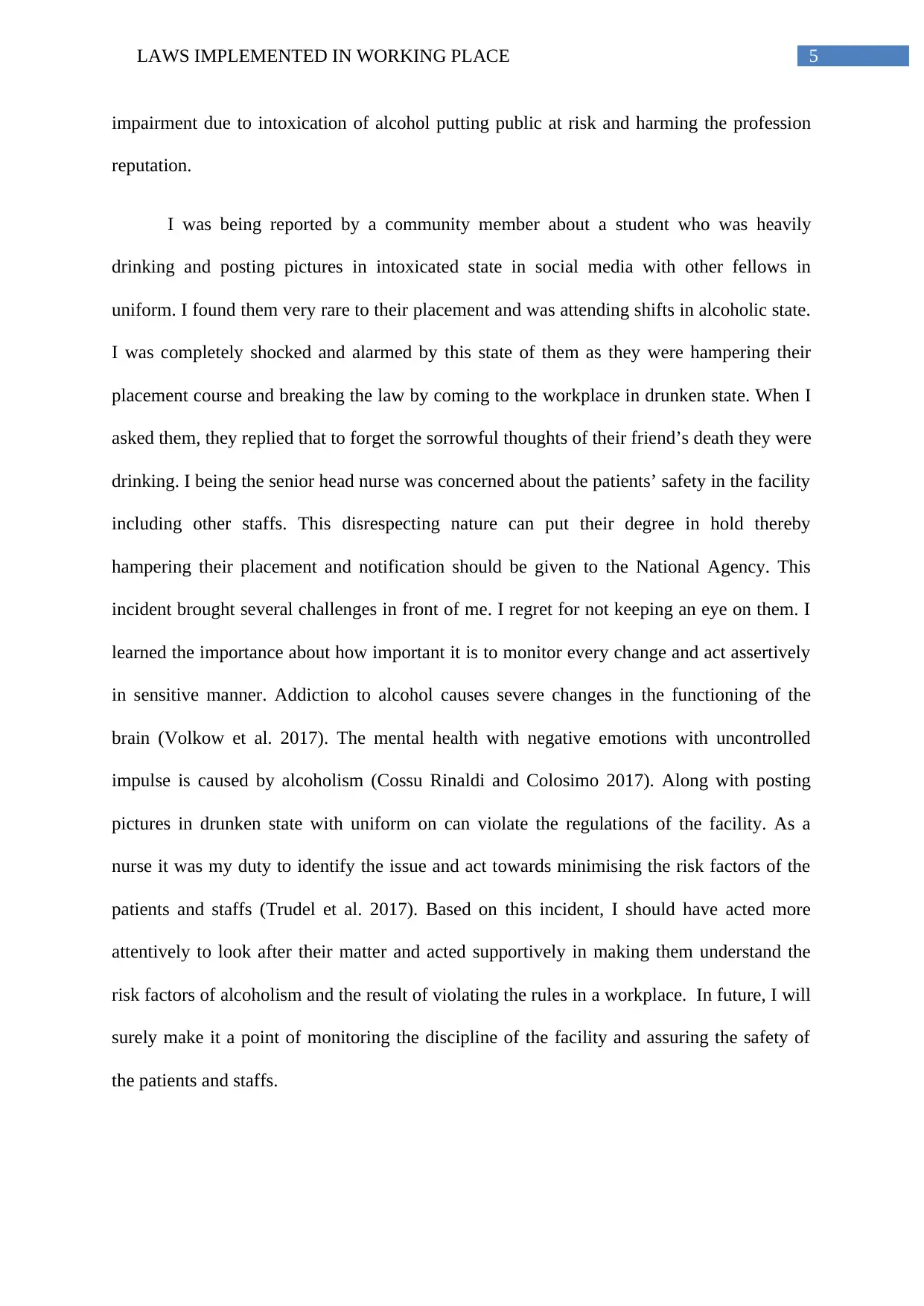
5LAWS IMPLEMENTED IN WORKING PLACE
impairment due to intoxication of alcohol putting public at risk and harming the profession
reputation.
I was being reported by a community member about a student who was heavily
drinking and posting pictures in intoxicated state in social media with other fellows in
uniform. I found them very rare to their placement and was attending shifts in alcoholic state.
I was completely shocked and alarmed by this state of them as they were hampering their
placement course and breaking the law by coming to the workplace in drunken state. When I
asked them, they replied that to forget the sorrowful thoughts of their friend’s death they were
drinking. I being the senior head nurse was concerned about the patients’ safety in the facility
including other staffs. This disrespecting nature can put their degree in hold thereby
hampering their placement and notification should be given to the National Agency. This
incident brought several challenges in front of me. I regret for not keeping an eye on them. I
learned the importance about how important it is to monitor every change and act assertively
in sensitive manner. Addiction to alcohol causes severe changes in the functioning of the
brain (Volkow et al. 2017). The mental health with negative emotions with uncontrolled
impulse is caused by alcoholism (Cossu Rinaldi and Colosimo 2017). Along with posting
pictures in drunken state with uniform on can violate the regulations of the facility. As a
nurse it was my duty to identify the issue and act towards minimising the risk factors of the
patients and staffs (Trudel et al. 2017). Based on this incident, I should have acted more
attentively to look after their matter and acted supportively in making them understand the
risk factors of alcoholism and the result of violating the rules in a workplace. In future, I will
surely make it a point of monitoring the discipline of the facility and assuring the safety of
the patients and staffs.
impairment due to intoxication of alcohol putting public at risk and harming the profession
reputation.
I was being reported by a community member about a student who was heavily
drinking and posting pictures in intoxicated state in social media with other fellows in
uniform. I found them very rare to their placement and was attending shifts in alcoholic state.
I was completely shocked and alarmed by this state of them as they were hampering their
placement course and breaking the law by coming to the workplace in drunken state. When I
asked them, they replied that to forget the sorrowful thoughts of their friend’s death they were
drinking. I being the senior head nurse was concerned about the patients’ safety in the facility
including other staffs. This disrespecting nature can put their degree in hold thereby
hampering their placement and notification should be given to the National Agency. This
incident brought several challenges in front of me. I regret for not keeping an eye on them. I
learned the importance about how important it is to monitor every change and act assertively
in sensitive manner. Addiction to alcohol causes severe changes in the functioning of the
brain (Volkow et al. 2017). The mental health with negative emotions with uncontrolled
impulse is caused by alcoholism (Cossu Rinaldi and Colosimo 2017). Along with posting
pictures in drunken state with uniform on can violate the regulations of the facility. As a
nurse it was my duty to identify the issue and act towards minimising the risk factors of the
patients and staffs (Trudel et al. 2017). Based on this incident, I should have acted more
attentively to look after their matter and acted supportively in making them understand the
risk factors of alcoholism and the result of violating the rules in a workplace. In future, I will
surely make it a point of monitoring the discipline of the facility and assuring the safety of
the patients and staffs.
⊘ This is a preview!⊘
Do you want full access?
Subscribe today to unlock all pages.

Trusted by 1+ million students worldwide
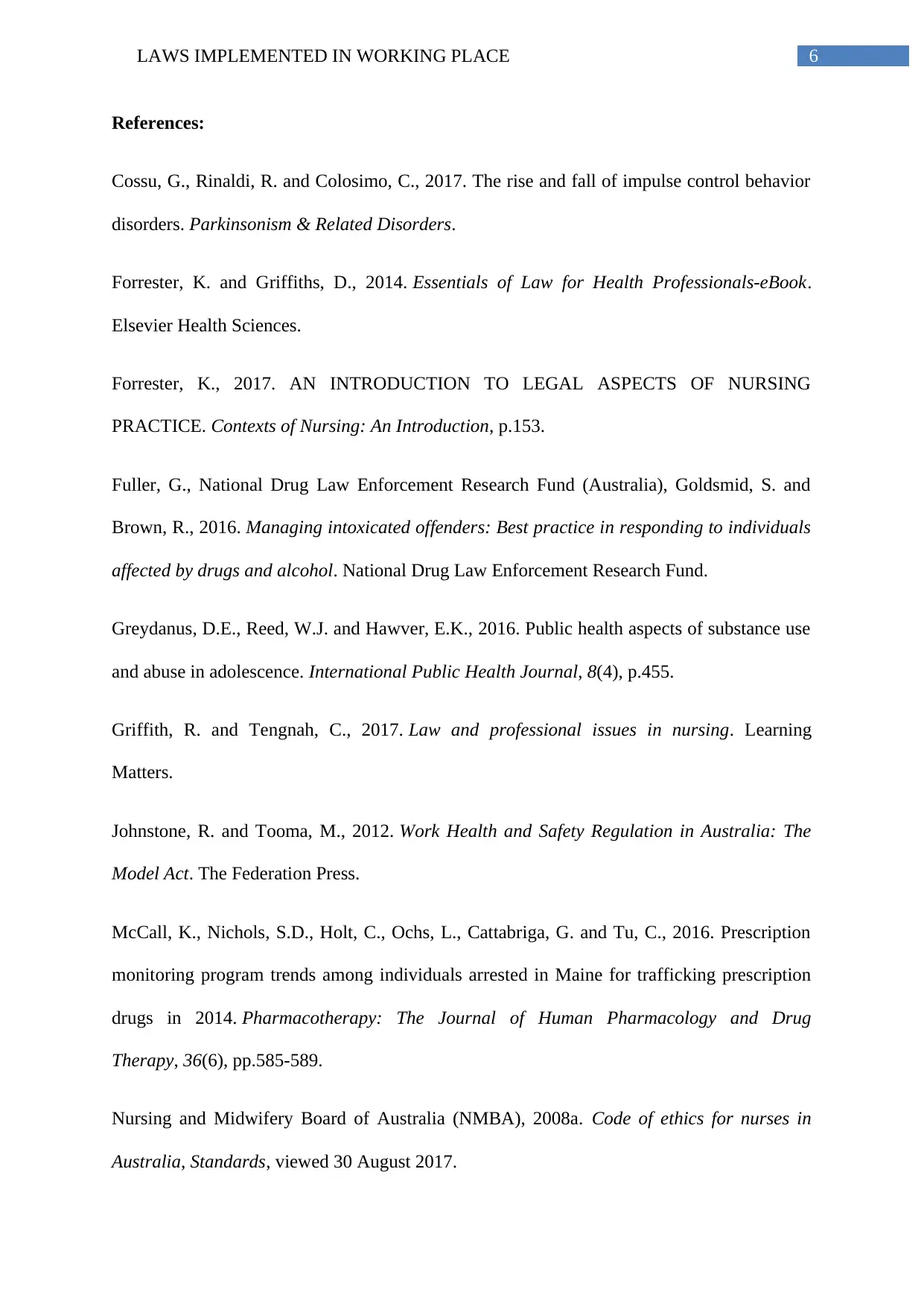
6LAWS IMPLEMENTED IN WORKING PLACE
References:
Cossu, G., Rinaldi, R. and Colosimo, C., 2017. The rise and fall of impulse control behavior
disorders. Parkinsonism & Related Disorders.
Forrester, K. and Griffiths, D., 2014. Essentials of Law for Health Professionals-eBook.
Elsevier Health Sciences.
Forrester, K., 2017. AN INTRODUCTION TO LEGAL ASPECTS OF NURSING
PRACTICE. Contexts of Nursing: An Introduction, p.153.
Fuller, G., National Drug Law Enforcement Research Fund (Australia), Goldsmid, S. and
Brown, R., 2016. Managing intoxicated offenders: Best practice in responding to individuals
affected by drugs and alcohol. National Drug Law Enforcement Research Fund.
Greydanus, D.E., Reed, W.J. and Hawver, E.K., 2016. Public health aspects of substance use
and abuse in adolescence. International Public Health Journal, 8(4), p.455.
Griffith, R. and Tengnah, C., 2017. Law and professional issues in nursing. Learning
Matters.
Johnstone, R. and Tooma, M., 2012. Work Health and Safety Regulation in Australia: The
Model Act. The Federation Press.
McCall, K., Nichols, S.D., Holt, C., Ochs, L., Cattabriga, G. and Tu, C., 2016. Prescription
monitoring program trends among individuals arrested in Maine for trafficking prescription
drugs in 2014. Pharmacotherapy: The Journal of Human Pharmacology and Drug
Therapy, 36(6), pp.585-589.
Nursing and Midwifery Board of Australia (NMBA), 2008a. Code of ethics for nurses in
Australia, Standards, viewed 30 August 2017.
References:
Cossu, G., Rinaldi, R. and Colosimo, C., 2017. The rise and fall of impulse control behavior
disorders. Parkinsonism & Related Disorders.
Forrester, K. and Griffiths, D., 2014. Essentials of Law for Health Professionals-eBook.
Elsevier Health Sciences.
Forrester, K., 2017. AN INTRODUCTION TO LEGAL ASPECTS OF NURSING
PRACTICE. Contexts of Nursing: An Introduction, p.153.
Fuller, G., National Drug Law Enforcement Research Fund (Australia), Goldsmid, S. and
Brown, R., 2016. Managing intoxicated offenders: Best practice in responding to individuals
affected by drugs and alcohol. National Drug Law Enforcement Research Fund.
Greydanus, D.E., Reed, W.J. and Hawver, E.K., 2016. Public health aspects of substance use
and abuse in adolescence. International Public Health Journal, 8(4), p.455.
Griffith, R. and Tengnah, C., 2017. Law and professional issues in nursing. Learning
Matters.
Johnstone, R. and Tooma, M., 2012. Work Health and Safety Regulation in Australia: The
Model Act. The Federation Press.
McCall, K., Nichols, S.D., Holt, C., Ochs, L., Cattabriga, G. and Tu, C., 2016. Prescription
monitoring program trends among individuals arrested in Maine for trafficking prescription
drugs in 2014. Pharmacotherapy: The Journal of Human Pharmacology and Drug
Therapy, 36(6), pp.585-589.
Nursing and Midwifery Board of Australia (NMBA), 2008a. Code of ethics for nurses in
Australia, Standards, viewed 30 August 2017.
Paraphrase This Document
Need a fresh take? Get an instant paraphrase of this document with our AI Paraphraser
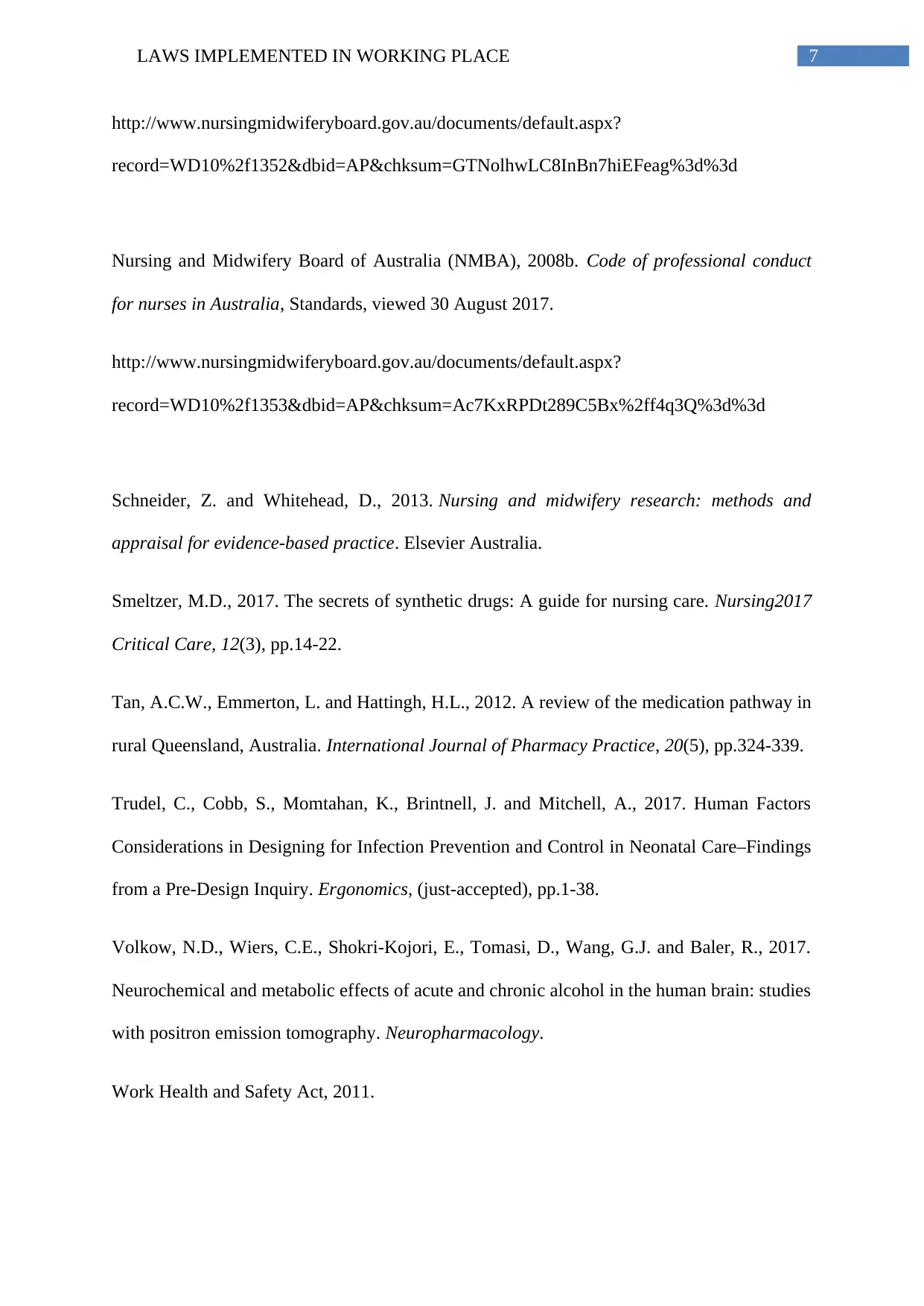
7LAWS IMPLEMENTED IN WORKING PLACE
http://www.nursingmidwiferyboard.gov.au/documents/default.aspx?
record=WD10%2f1352&dbid=AP&chksum=GTNolhwLC8InBn7hiEFeag%3d%3d
Nursing and Midwifery Board of Australia (NMBA), 2008b. Code of professional conduct
for nurses in Australia, Standards, viewed 30 August 2017.
http://www.nursingmidwiferyboard.gov.au/documents/default.aspx?
record=WD10%2f1353&dbid=AP&chksum=Ac7KxRPDt289C5Bx%2ff4q3Q%3d%3d
Schneider, Z. and Whitehead, D., 2013. Nursing and midwifery research: methods and
appraisal for evidence-based practice. Elsevier Australia.
Smeltzer, M.D., 2017. The secrets of synthetic drugs: A guide for nursing care. Nursing2017
Critical Care, 12(3), pp.14-22.
Tan, A.C.W., Emmerton, L. and Hattingh, H.L., 2012. A review of the medication pathway in
rural Queensland, Australia. International Journal of Pharmacy Practice, 20(5), pp.324-339.
Trudel, C., Cobb, S., Momtahan, K., Brintnell, J. and Mitchell, A., 2017. Human Factors
Considerations in Designing for Infection Prevention and Control in Neonatal Care–Findings
from a Pre-Design Inquiry. Ergonomics, (just-accepted), pp.1-38.
Volkow, N.D., Wiers, C.E., Shokri-Kojori, E., Tomasi, D., Wang, G.J. and Baler, R., 2017.
Neurochemical and metabolic effects of acute and chronic alcohol in the human brain: studies
with positron emission tomography. Neuropharmacology.
Work Health and Safety Act, 2011.
http://www.nursingmidwiferyboard.gov.au/documents/default.aspx?
record=WD10%2f1352&dbid=AP&chksum=GTNolhwLC8InBn7hiEFeag%3d%3d
Nursing and Midwifery Board of Australia (NMBA), 2008b. Code of professional conduct
for nurses in Australia, Standards, viewed 30 August 2017.
http://www.nursingmidwiferyboard.gov.au/documents/default.aspx?
record=WD10%2f1353&dbid=AP&chksum=Ac7KxRPDt289C5Bx%2ff4q3Q%3d%3d
Schneider, Z. and Whitehead, D., 2013. Nursing and midwifery research: methods and
appraisal for evidence-based practice. Elsevier Australia.
Smeltzer, M.D., 2017. The secrets of synthetic drugs: A guide for nursing care. Nursing2017
Critical Care, 12(3), pp.14-22.
Tan, A.C.W., Emmerton, L. and Hattingh, H.L., 2012. A review of the medication pathway in
rural Queensland, Australia. International Journal of Pharmacy Practice, 20(5), pp.324-339.
Trudel, C., Cobb, S., Momtahan, K., Brintnell, J. and Mitchell, A., 2017. Human Factors
Considerations in Designing for Infection Prevention and Control in Neonatal Care–Findings
from a Pre-Design Inquiry. Ergonomics, (just-accepted), pp.1-38.
Volkow, N.D., Wiers, C.E., Shokri-Kojori, E., Tomasi, D., Wang, G.J. and Baler, R., 2017.
Neurochemical and metabolic effects of acute and chronic alcohol in the human brain: studies
with positron emission tomography. Neuropharmacology.
Work Health and Safety Act, 2011.
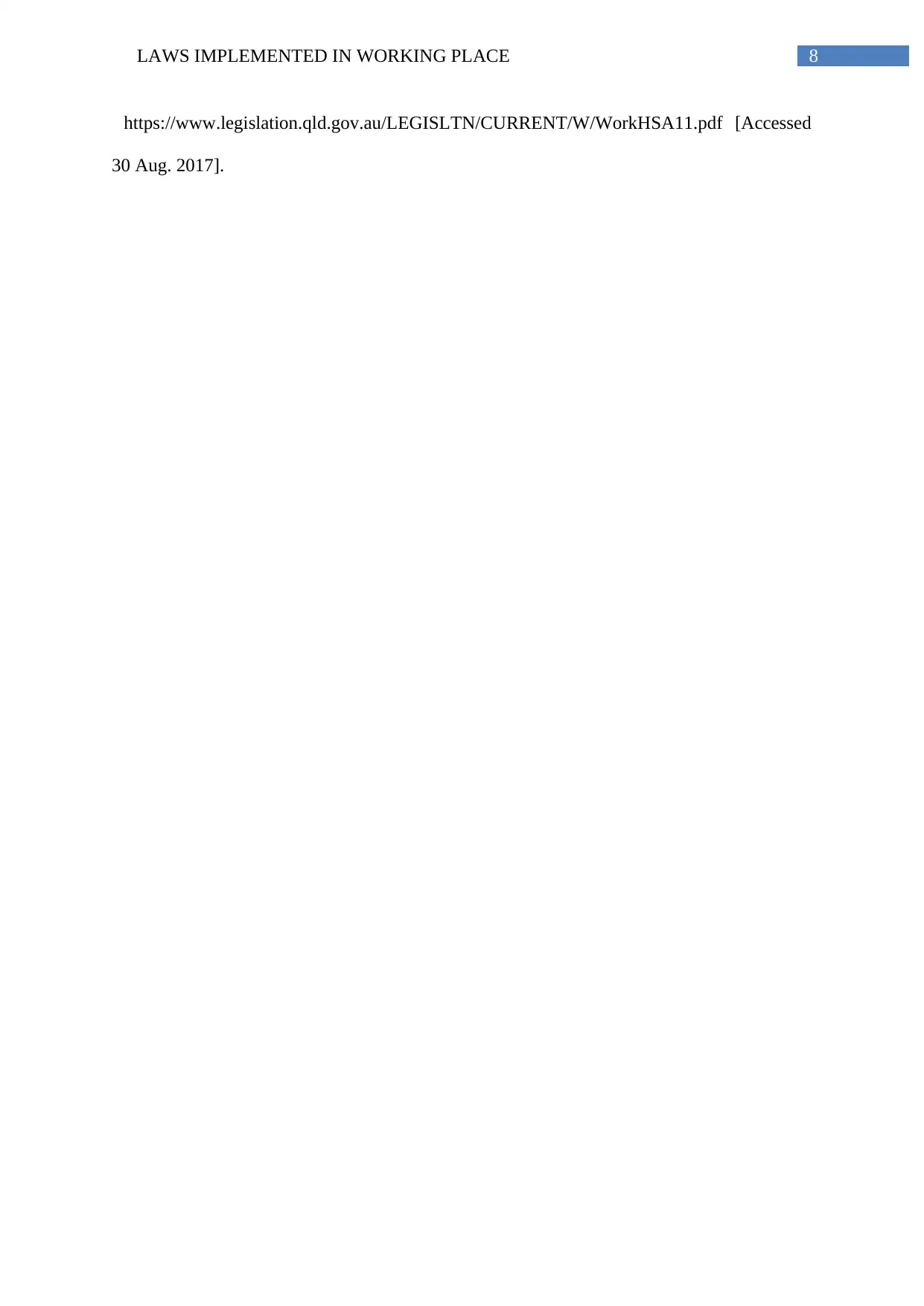
8LAWS IMPLEMENTED IN WORKING PLACE
https://www.legislation.qld.gov.au/LEGISLTN/CURRENT/W/WorkHSA11.pdf [Accessed
30 Aug. 2017].
https://www.legislation.qld.gov.au/LEGISLTN/CURRENT/W/WorkHSA11.pdf [Accessed
30 Aug. 2017].
⊘ This is a preview!⊘
Do you want full access?
Subscribe today to unlock all pages.

Trusted by 1+ million students worldwide
1 out of 9
Related Documents
Your All-in-One AI-Powered Toolkit for Academic Success.
+13062052269
info@desklib.com
Available 24*7 on WhatsApp / Email
![[object Object]](/_next/static/media/star-bottom.7253800d.svg)
Unlock your academic potential
Copyright © 2020–2025 A2Z Services. All Rights Reserved. Developed and managed by ZUCOL.



